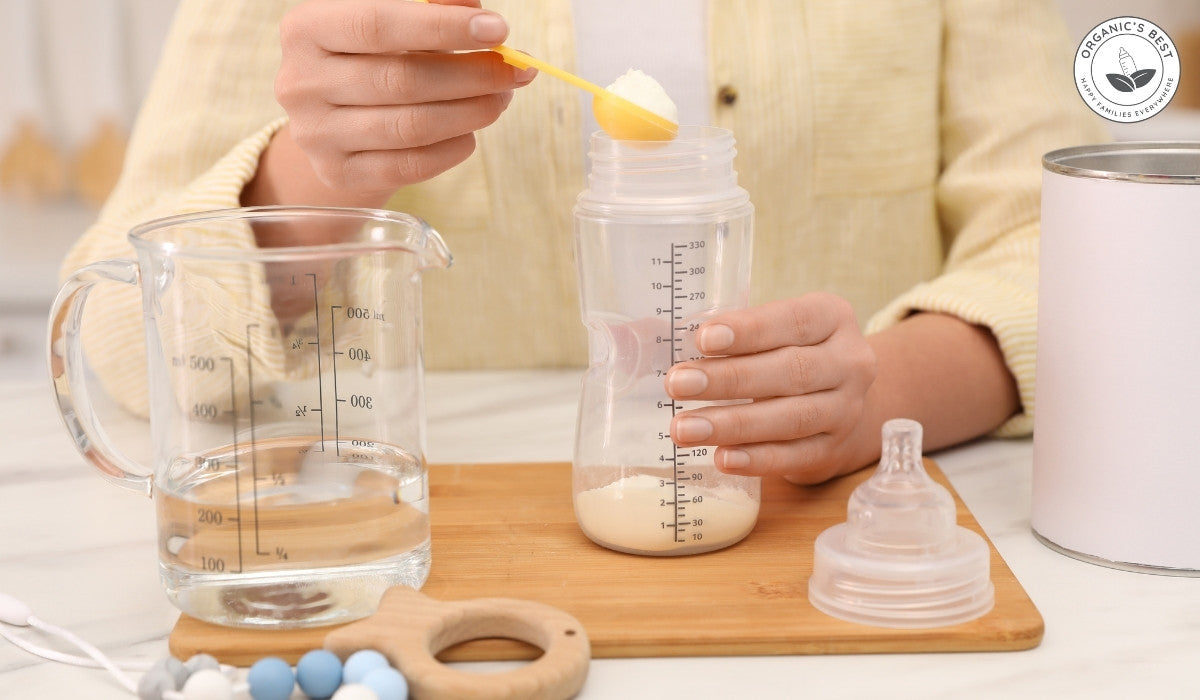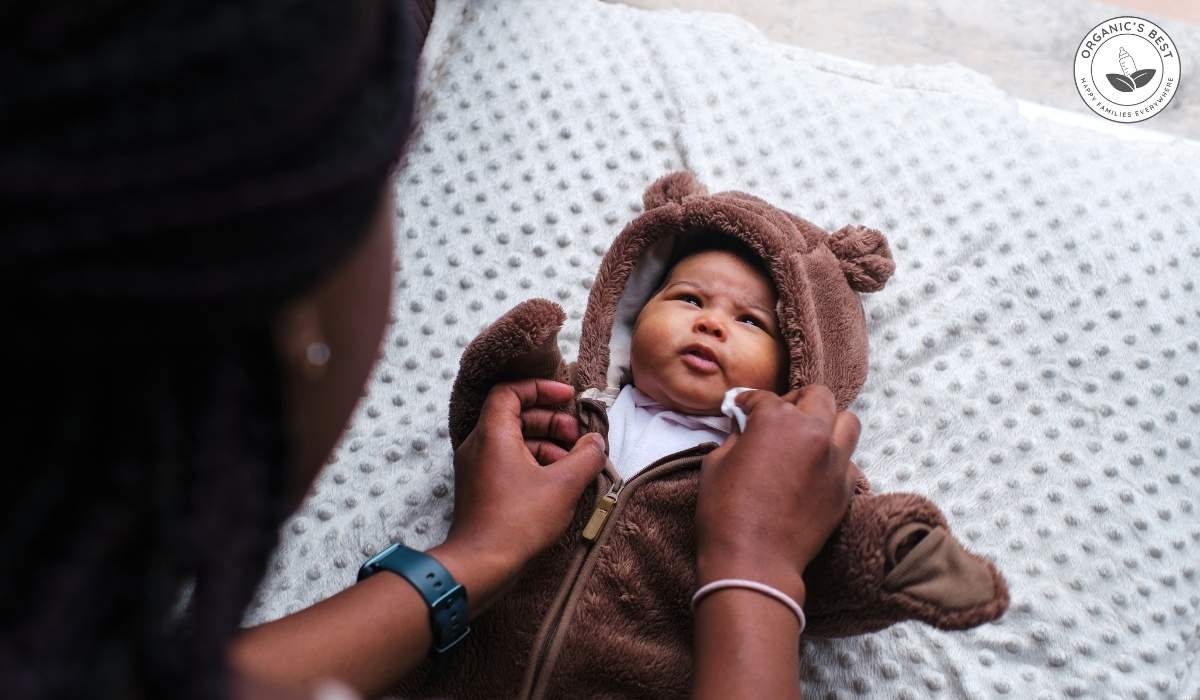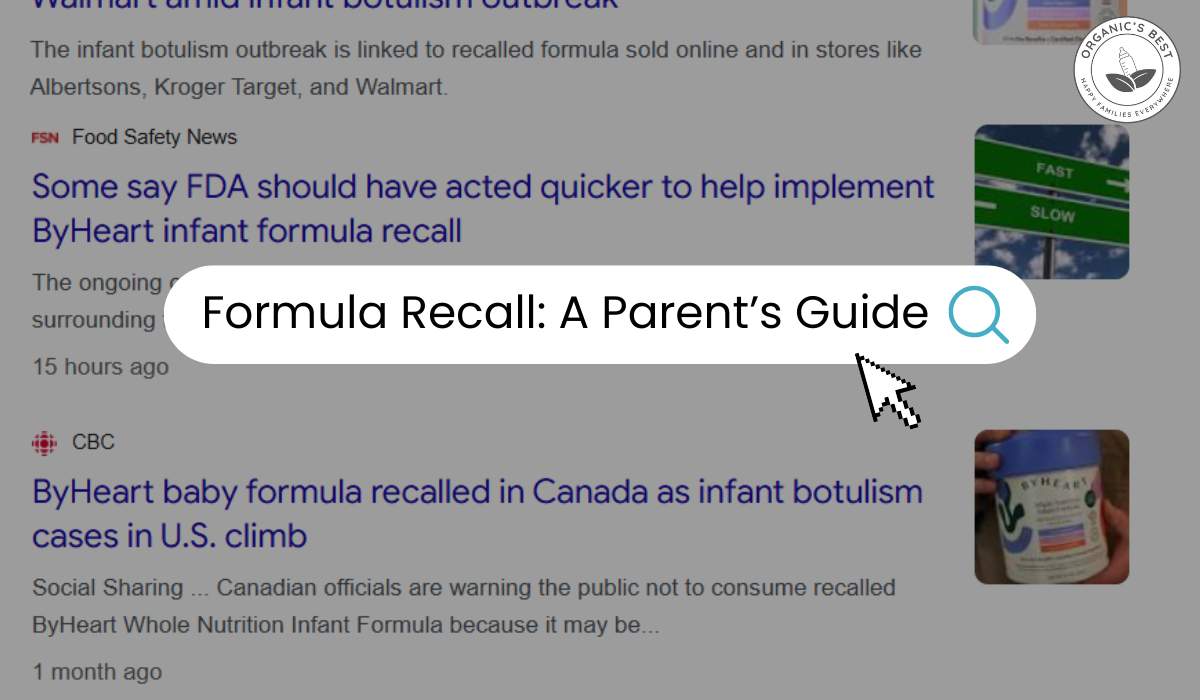Click to Get 2 FREE Boxes/Cans
Only New Customers! Click HERE to Get 2 Extra Boxes/Cans for Free With Your First Order.
BABY FORMULA
Offering new parents top-quality European infant formula from renowned brands like HiPP, Holle, Kendamil, and more. If you’re uncertain about which product to choose, our Formula Finder can help you make the best decision for your baby.
Baby Food
Offering new parents a premium selection of European baby foods, including jars, pouches, cereals, and snacks from esteemed brands like HiPP and Holle.
Formula Measuring and Mixing Made Simple
by Agustina Fernandez October 17, 2023 9 min read

The journey of parenthood is a remarkable adventure filled with countless moments of joy, discovery, and growth. For parents who have chosen or found themselves embracing the path of formula feeding, this journey comes with its own set of questions and considerations.
From selecting the right formula for your little one's nutritional needs to navigating the intricate process of preparation, the world of formula feeding can initially appear complex and overwhelming. This is because, unlike breastfeeding, where nature provides the perfect balance of nutrients in each drop, formula feeding requires meticulous measurement and mixing to ensure your baby receives optimal nutrition.
That's why we've crafted this guide – to empower you with the knowledge and techniques needed to navigate the world of formula measuring and mixing with confidence, so you can prepare your baby's formula like a pro.
From understanding the different types of formulas to learning the proper measuring methods and tools, we're here to demystify the process and equip you with the skills you need to provide your baby with safe and nourishing feedings.
Table of contents
- Understanding the Importance of Correct Infant Formula Measurements
- The Basic Formula Equation: Water + Formula Powder = Prepared Formula
- Your Step-by-Step Guide to Perfect Formula Measurements
- Tools of the Trade: Choosing the Right Equipment
- The Impact of Water Quality on Formula Measurements
- The "Oops" Moments: Handling Measurement Errors
- Additional Tips for Formula Feeding Success
- Answering Your Queries: Frequently Asked Questions About Formula Measurements
Understanding the Importance of Correct Infant Formula Measurements
Accurate formula measurements play a pivotal role in providing your baby with the essential nutrients they need for healthy growth and development. The right balance of formula and water ensures a consistent intake of calories, proteins, fats, vitamins, and minerals in your baby's bottle.
Here are some potential risks of incorrect formula measurements:

1) Too much water/too little formula (diluted formula)
One diluted bottle isn’t likely to cause a major problem, but over time feeding your baby diluted formula can lead to serious health issues. Babies do not require extra water in addition to formula or breast milk during their first 6 months of life.
Giving your baby a bottle with just water can be dangerous and lead to water intoxication. This occurs when a baby has too much water, which disrupts electrolyte levels, causing symptoms like fussiness, sleepiness, vomiting, and even seizures. It can also result in poor weight gain and developmental delays over time.
2) Too much formula/too little water (over-concentrated formula)
Repeatedly over-mixing formula over time can have serious side effects like dehydration, as the excess formula can increase your baby's sodium levels, potentially causing salt and water imbalances, seizures, brain damage, and kidney issues. Signs of dehydration include sleepiness, reduced diaper wetness, dark urine, dry mouth, and a sunken spot on the head.
The Basic Formula Equation: Water + Formula Powder = Prepared Formula
A bottle of formula is composed of two essential components: water and powder formula. Water serves as the foundation, acting as a medium to dilute and mix the formula powder, while the formula powder contains a balanced combination of nutrients tailored to your baby's needs.
It's essential to follow the manufacturer's instructions and guidelines for preparing your baby's formula. Modifying the water-to-powder ratio can disrupt the carefully formulated nutritional balance, impacting your baby's overall health. Stick to the recommended measurements to ensure your baby receives the appropriate nutrition for their age and stage of development.
Your Step-by-Step Guide to Perfect Formula Measurements
There are different kinds of formulas that can be used to feed your little one. They are concentrated liquid formula, powdered infant formula, and ready-to-feed liquid formula.
In this article, we are focusing on powdered formula because it's the most popular choice, so here's the best way to measure it!
Starting right: Why we should always start with water
Step one should always be measuring your water, usually by using the ounce markings on the bottle. Clear, clean, and preferably distilled water provides the base for creating a balanced and nutritious feeding solution. By starting with water, you establish a foundation upon which the formula powder can be precisely measured and mixed.
The right way to measure formula powder

Once the water is ready, it's time to add the powder formula. To ensure precision, follow these steps and then you'll be ready to feed formula to your little one.
-
Use a clean, dry, and appropriately sized scoop provided by the formula manufacturer. Different formulas might have slightly different scoop sizes, so always use the one that comes with the specific formula you are using.
-
Fill the scoop with formula powder, then level it off using a clean, flat edge. Avoid tapping or shaking the scoop to level it, as this can lead to inconsistencies in measurement.
-
Add the levelled formula powder to the bottle containing the measured water. This ensures that the formula is accurately proportioned and mixed.
Discover the secrets to preparing perfect baby formula with our step-by-step video guide. Watch as we walk you through the process and take the guesswork out of preparation to help you feel confident after every bottle. Click here to watch and learn!
Tools of the Trade: Choosing the Right Equipment
The tools you choose to mix and measure baby formula can greatly influence the quality and safety of each feeding. Accurate measuring tools ensure that the water-to-formula ratio remains consistent, providing your baby with the appropriate nutrition every time.
Baby Feeding Equipment

Check out the following equipment to help you on your formula-feeding journey:
Baby Bottles: Opt for bottles with clear volume markings that are easy to read. Bottles with wide openings facilitate easy pouring of formula powder and water.
Measuring Spoons or Scoops: Always use the measuring spoon or scoop that comes with the specific formula you're using. These are designed to provide accurate measurements for that formula's composition.
Formula Dispenser: When on the go, a formula dispenser or formula container can help you carry pre-measured formula powder conveniently. Look for a dispenser with separate compartments to keep each feeding portion hygienically separated.
Food Scale: If you misplace your baby's formula scoop, in emergency situations, you can also measure formula powder by weight with a reliable food scale. Ensure the scale is accurate and easy to use for precise measurements.
The Impact of Water Quality on Formula Measurements
The quality of water used to prepare a baby bottle is a fundamental factor that can significantly impact your baby's health and the accuracy of formula measurements. Water serves as the medium through which formula powder is mixed, making its purity and safety of utmost importance.
Impurities, contaminants, or inadequate water treatment can not only affect the taste and appearance of the formula but also pose potential health risks to your baby. It is strongly advised to boil water before using it in formula preparation, regardless of its source.
Opt for distilled, purified, or filtered tap water. Even if your tap water comes from a municipally treated source, boiling it for one minute and allowing it to cool before mixing it with formula ensures added safety. Bottled water made specifically for formula preparation can also be used but should still be boiled first. Finally, for those relying on well water, routine testing for contaminants is crucial to guarantee water safety.
To summarize, prioritizing clean, boiled water as the base for formula ensures the optimal well-being of your baby's nutrition journey. Make sure that before feeding your baby, you allow the water to cool down to room temperature.
The "Oops" Moments: Handling Measurement Errors
Even with the best intentions and efforts, mistakes can happen during formula preparation. Recognizing when a measurement error has occurred is vital for addressing the situation promptly. Signs of potential measurement errors include changes in the consistency of the formula, such as being too watery or too thick, or when your baby's feeding habits and behaviours deviate from the norm.
What to do when you’ve made a formula measuring mistake
So now you're probably wondering, what do I do when I've made a formula-measuring mistake?
Regardless of how the baby formula is inaccurately prepared, it could pose risks to your baby's well-being. If you haven't yet offered them the improperly mixed formula, it's advisable to discard it and prepare a new fresh bottle.
If you suspect your baby has consumed infant formula with a measurement mistake, closely monitor their behaviour and health. If there are any signs of discomfort, unusual behaviour, or digestive issues, consult your healthcare provider for guidance.
Remember, it's human to make errors. By staying vigilant and responsive to potential mistakes when measuring formula powder, you can quickly rectify the situation and ensure your baby's feeding remains consistent and safe. Always follow proper guidelines for prepared formula and consult with your healthcare provider if you have concerns.
Additional Tips for Formula Feeding Success
To ensure the best experience for both you and your little one, here are some additional tips that can contribute to a successful formula-feeding journey:
Storage and handling tips for preserving the formula's nutritional quality

Proper Storage Temperature: Always store prepared formula in the refrigerator at a temperature of 40°F (4°C) or lower. This helps to prevent the growth of harmful bacteria.
Follow Time Limits: Prepared formula should be used within 24 hours if kept in the refrigerator. If kept at room temperature must be used within 2 hours of preparation and within one hour from when feeding begins
Don't Freeze Formula: Freezing can negatively impact the formula's consistency and nutrient content. Use refrigeration instead.
Shake Gently: If using powdered formula, mix it gently to avoid excessive air bubbles. This can help reduce the likelihood of gas in your baby's tummy.
Check out: How Long is Formula Good For?
Key reminders on safe and healthy formula feeding practices
Maintain Hygiene: Wash your hands thoroughly before preparing formula. Ensure that all feeding equipment, such as bottles, nipples, and utensils, are properly cleaned and sanitized.
Responsive Feeding: Pay attention to your baby's cues of hunger and fullness. Don't force your baby to finish a bottle if they're not interested.
Learn More: How to Spot Baby Hunger Cues
Regular Burping: Gently burp your baby during and after feeding to release any swallowed air which can cause discomfort.
Comfortable Feeding Position: Hold your baby in a semi-upright position during feeding to reduce the risk of choking.
Frequently Asked Questions About Formula Measurements
If you find yourself with a few more questions in mind, keep reading to find some insightful answers to common queries.
What is the correct way to measure formula?
The correct way to measure formula is to follow the manufacturer's instructions on the packaging. Most formulas provide a scoop, and you should level off the scoop with a clean, flat surface to ensure an accurate measurement.
How do you measure formula without a scoop?
A kitchen scale capable of measuring to the tenth of a gram offers the most accurate alternative to the infant formula scoop. Every European baby formula powder producer has determined the nutritional content for each portion with precision down to the nearest tenth of a gram.
In emergency situations, you can estimate the right amount of grams per scoop by checking the package. However, it's important to find the measuring scoop as soon as possible for consistent accuracy.
What can I use to measure baby formula?
The most reliable option for measuring baby formula is a kitchen scale or scoop provided with the formula. Using a kitchen spoon is not recommended, as it's an approximation and may not provide an exact measurement.
Do you count ounces of formula before or after mixing?
For greater precision, it's recommended to introduce the formula after measuring the water. Putting the formula into the bottle prior to adding the water can lead to an error of 1–2 ounces and may also lead to undissolved formula clumps. Begin by measuring the water first, followed by the addition of the powder.
What happens if you measure baby formula wrong?
The primary concern when feeding your baby formula that is incorrectly mixed lies in the potential development of imbalances in their body's salt and electrolyte levels, which can pose a significant risk to their health. If you measure the formula wrong before feeding it to them, it is best to discard the prepared formula and make a new bottle.
Conclusion
Now that you have reached the end of this guide, we hope that you feel well-prepared to tackle formula feeding with ease and grace, ensuring that your little one receives the love and care they deserve in every single bottle!
Disclaimer:
Please be aware that this information is based on general trends in babies, and it is not medical advice. Your doctor should be your first source of information and advice when considering any changes to your child’s formula and when choosing your child’s formula. Always consult your pediatrician before making any decisions about your child’s diet or if you notice any changes in your child. Breastfeeding is the best nutrition for your baby because breast milk provides your child with all the essential nutrients they need for growth and development. Please consult your pediatrician if your child requires supplemental feeding. |
Agustina Fernandez
Dr. Agustina Fernandez earned her medical degree from the prestigious Universidad Nacional de Córdoba, Argentina. With a deep-rooted passion for pediatrics, Dr. Fernandez is currently on the path to specializing in children's healthcare. Recently, she has delved into the vital field of infant nutrition. Her research interests include breastfeeding, infant formula, and baby food in little ones’ formative years. Dr. Fernandez's commitment to this area of study underscores her dedication to ensuring the health and well-being of children from their earliest days.
Leave a comment
Comments will be approved before showing up.
Also in Organic Infant Nutrition and Health Blog

Winter Newborn Essentials: Checklist for Protecting New Babies in Cold Weather
by Agustina Fernandez December 30, 2025 9 min read
Read More
All You Need to Know About Formula Recall: A Parent’s Guide
by Agustina Fernandez December 23, 2025 8 min read
Read More
Everything You Need To Know About Winter Pregnancy: Essential Tips for Moms-to-be
by Agustina Fernandez December 16, 2025 8 min read
Read More
Reviewed by Dr. Bardha Citaku, MD
-

Dr. Bardha Citaku: Medical Reviewer of Organic's Best Blog
Dr. Bardha Citaku completed her medical studies at the University of Prishtina in Kosovo, where she began her journey into the field of medicine. She has since developed a career in medical research, contributing to projects with notable organizations, including the World Health Organization (WHO).

